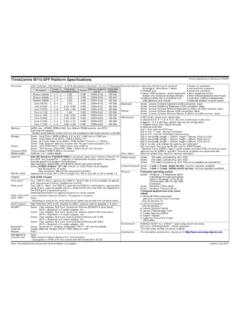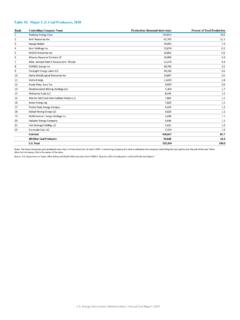Transcription of Fabry-Perot interferometers - Massachusetts Institute of …
1 1 MIT Optics10/24/05 wk8-a-1 Today s summary Multiple beam interferometers : Fabry-Perot resonators Stokes relationships Transmission and reflection coefficients for a dielectric slab Optical resonance Principles of lasers Coherence: spatial / temporalMIT Optics10/24/05 wk8-a-2 Fabry-Perot interferometers2 MIT Optics10/24/05 wk8-a-3 Relation between r, r and t, t aaratair glassa a r a t 12= + = ttrrrProof: algebraic from the Fresnel coefficientsor using the property of preservation of thepreservation of thefield properties upon time reversalfield properties upon time reversalglass airStokes relationshipsMIT Optics10/24/05 wk8-a-4 Proof using time reversalaaratair glassatt aratair glassatr artar2()()10 22= + = + = = +ttrattrarrtrra 3 MIT Optics10/24/05 wk8-a-5 Fabry-Perot InterferometerLincidentreflectedtransmit tedResonancecondition.
2 Reflected wave = 0 all reflected waves interfere destructivelynmL2 =wavelength in free spacerefractive indexMIT Optics10/24/05 wk8-a-6 Calculation of the reflected waveincoming areflected artransmitted atei reflected atei2 r transmitted atei t reflected atei3 (r )2transmitted atei2 r t reflected atei4 (r )3transmitted atei3 (r t )2reflected atei5 (r )4transmitted atei4 (r )3t air, n=1glass, nair, n=1 nL2=4 MIT Optics10/24/05 wk8-a-7 Calculation of the reflected wave(){} +=+ + + += 22244222reflectede11e ee1eiiiiirrttrarrrttraaLUse Stokes relationships12= + = ttrrr() 222reflectede1e1 iirraa =MIT Optics10/24/05 wk8-a-8 Transmission & reflection coefficients() 222reflectede1 e1iirraa = 22dtransmittee1irttaa =()()() 2222dtransmitte2222reflectedsin411tcoeff icienontransmissisin41sin4tcoefficienref lectionRRRaaRRRaa+ == + == 2rR 5 MIT Optics10/24/05 wk8-a-9 Transmission & reflection vspathR= Optics10/24/05 wk8-a-10 Fabry-Perot terminologynLmc2()nLcm21+()nLcm22+freque ncy bandwidthfreespectralrangeresonancefrequ encies6 MIT Optics10/24/05 wk8-a-11 Fabry-Perot terminologyFWHM Bandwidth is inversely proportionalto the finessefinesseF (or quality factorquality factor)of the cavity FWHMRRF 1 FSRnLFc2 FWHM= FFSRFWHM = ()()()
3 Finesserange spectral freebandwidth=MIT Optics10/24/05 wk8-a-12 Spectroscopy using Fabry-Perot cavityExperimental measurement principle:Experimental measurement principle:container with specimen to be measuredtransparentwindowslight beam ofknown spectrumspectrum of light beamis modified by substancepartially reflectingmirrors (FP cavity)powermeterGoal: Goal: to measure the specimen s absorption as function offrequency scanningstage(controls cavitylength L)7 MIT Optics10/24/05 wk8-a-13 Spectroscopy using Fabry-Perot cavityExperimental measurement principle:Experimental measurement principle:container with specimen to be measuredtransparentwindowslight beam ofknown spectrumspectrum of light beamis modified by substancepartially reflectingmirrors (FP cavity)powermeterGoal: Goal: to measure the specimen s absorption as function offrequency electro-optic(EO) modulator(controls n)MIT Optics10/24/05 wk8-a-14 Spectroscopy using Fabry-Perot cavity I( )unknownspectrumFabry Perottransmissivity 1sample measured:I( 1)8 MIT Optics10/24/05 wk8-a-15 Spectroscopy using Fabry-Perot cavity I( )unknownspectrumFabry Perottransmissivity 2sample measured:I( 2)MIT Optics10/24/05 wk8-a-16 Spectroscopy using Fabry-Perot cavity I( )unknownspectrumFabry Perottransmissivity 3sample measured.
4 I( 3)9 MIT Optics10/24/05 wk8-a-17 Spectroscopy using Fabry-Perot cavity I( )unknownspectrumFabry Perottransmissivity 3sample measured:I( 3)unknown spectrumwidth should not exceed the FSRMIT Optics10/24/05 wk8-a-18 Spectroscopy using Fabry-Perot cavity I( )unknownspectrumFabry Perottransmissivity 3sample measured:I( 3)spectral resolutionspectral resolutionis determined by thecavity bandwidth10 MIT Optics10/24/05 wk8-a-19 LasersMIT Optics10/24/05 wk8-a-20 Absorption spectra ( m)Atmospheric transmissionhuman vision11 MIT Optics10/24/05 wk8-a-21 Semi-classical view of atom excitationsEnergyEnergyAtom in ground stateAtom in ground stateAtom in excited stateAtom in excited stateZe+e-MIT Optics10/24/05 wk8-a-22 Light generationground stateexcited stateequilibrium.
5 Most atomsin ground stateEnergy12 MIT Optics10/24/05 wk8-a-23 Light generationground stateexcited stateA pumpmechanism ( thermal excitation or gas discharge) ejects some atoms to the excited stateEnergyMIT Optics10/24/05 wk8-a-24 Light generationground stateexcited stateThe excited atoms radiativelydecay, emitting one photon eachEnergyh h 13 MIT Optics10/24/05 wk8-a-25 Light amplification: 3-level systemground stateequilibrium:most atomsin ground state; note the existenceof a third, super-excited stateEnergysuper-excited stateexcited stateMIT Optics10/24/05 wk8-a-26 Light amplification: 3-level systemground stateUtilizing the super-excited stateas a short-lived pivot point, thepump creates a population inversionEnergysuper-excited stateexcited state14 MIT Optics10/24/05 wk8-a-27 Light amplification: 3-level systemground stateWhen a photon enters.
6 Energysuper-excited stateexcited stateh MIT Optics10/24/05 wk8-a-28 Light amplification: 3-level systemground stateEnergysuper-excited stateexcited stateh When a photon enters, it knocks an electron from the inverted population down to the ground state, thus creatinga new photon. This amplification process is called stimulated emissionh h 15 MIT Optics10/24/05 wk8-a-29 Light amplifierGain medium( 3-level systemw population inversion)PinPout =gPinMIT Optics10/24/05 wk8-a-30 Light amplifier w positive feedbackGain medium( 3-level systemw population inversion)PinPout =gPing ++When the gain exceeds the roundtrip losses, the system goes into oscillation16 MIT Optics10/24/05 wk8-a-31 LaserGain medium( 3-level systemw population inversion)LightAmplification throughStimulatedEmission ofRadiationinitial photonPartiallyreflectingmirrorMIT Optics10/24/05 wk8-a-32 LaserGain medium( 3-level systemw population inversion)
7 LightAmplification throughStimulatedEmission ofRadiationinitial photonamplified oncePartiallyreflectingmirror17 MIT Optics10/24/05 wk8-a-33 LaserGain medium( 3-level systemw population inversion)LightAmplification throughStimulatedEmission ofRadiationinitial photonamplified oncereflectedPartiallyreflectingmirrorMI T Optics10/24/05 wk8-a-34 LaserGain medium( 3-level systemw population inversion)LightAmplification throughStimulatedEmission ofRadiationinitial photonamplified oncereflectedamplified twicePartiallyreflectingmirror18 MIT Optics10/24/05 wk8-a-35 LaserGain medium( 3-level systemw population inversion)LightAmplification throughStimulatedEmission ofRadiationinitial photonamplified oncereflectedamplified twicePartiallyreflectingmirrorreflectedo utputMIT Optics10/24/05 wk8-a-36 LaserGain medium( 3-level systemw population inversion)LightAmplification throughStimulatedEmission ofRadiationinitial photonamplified oncereflectedamplified twicePartiallyreflectingmirrorreflectedo utputamplified Optics10/24/05 wk8-a-37 Confocal laser cavitieswaist w0diffractionangle0tannw =Beam profile.
8 2D Gaussian function TE00mode MIT Optics10/24/05 wk8-a-38 Other transverse modes TE10TE11(usually undesirable)20 MIT Optics10/24/05 wk8-a-39 Types of lasers Continuous wave (cw) Pulsed Q-switched mode-locked Gas (Ar-ion, HeNe, CO2) Solid state (Ruby, Nd:YAG, Ti:Sa) Diode (semiconductor) Vertical cavity surface-emitting lasers VCSEL (also sc) Excimer (usually ultra-violet)MIT Optics10/24/05 wk8-a-40CW (continuous wave lasers)1/ tLaser oscillation well approximated by a sinusoidTypical sources: Argon-ion: 488nm (blue) or 514nm (green); power ~1-20W Helium-Neon (HeNe): 633nm (red), also in green and yellow; ~1-100mW doubled Nd:YaG: 532nm (green); ~1-10 WQuality of sinusoid maintained over a time duration known as coherence time tcTypical coherence times ~20nsec (HeNe), ~10 sec (doubled Nd.)
9 YAG)21 MIT Optics10/24/05 wk8-a-41 Two types of incoherenced1d2 Michelson interferometerYoung interferometer1r1r2rspatialspatialincohe renceincoherencetemporaltemporalincohere nceincoherencepointsourcematchedpathspol y-chromatic light(=multi-color, broadband)mono-chromatic light(= single color, narrowband)MIT Optics10/24/05 wk8-a-42 Two types of incoherenced1d21r1r2rspatialspatialincoh erenceincoherencetemporaltemporalincoher enceincoherencepointsourcematchedpathswa ves from unequal pathswaves from unequal pathsdo not interferedo not interferewaves with equal pathswaves with equal pathsbut from different pointsbut from different pointson the wavefronton the wavefrontdo not interferedo not interfere22 MIT Optics10/24/05 wk8-a-43 Coherent vs incoherent beamsMutually coherent: superposition field amplitudeamplitudeis described by sum of complex amplitudessum of complex amplitudes1e11 iaa=2e22 iaa=2212212121eeaaaIaaaaaii+==+=+= Mutually incoherent.
10 Superposition field intensityintensityis described by sum of intensitiessum of intensities1I21 III+=2I(the phases of the individual beams vary randomly with respect to each other; hence,we would need statistical formulation todescribe them properly statistical optics)MIT Optics10/24/05 wk8-a-44 Coherence time and coherence lengthincominglaserbeaml1l2 Michelson interferometerIntensityl1 l1-l2much shortershorter than coherence length ctcsharp interference fringesIntensityl1 l1-l2much longerlonger than coherence length ctcno interference02I0I023 MIT Optics10/24/05 wk8-a-45 Coherent vs incoherent beamsCoherent: superposition field amplitudeamplitudeis described by sum of complex amplitudessum of complex amplitudes1e11 iaa=2e22 iaa=2212212121eeaaaIaaaaaii+==+=+= Incoherent.
















